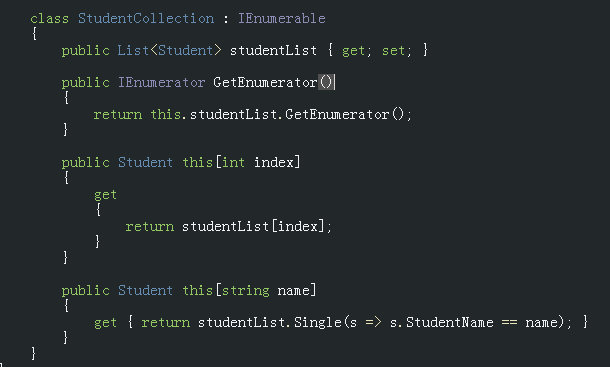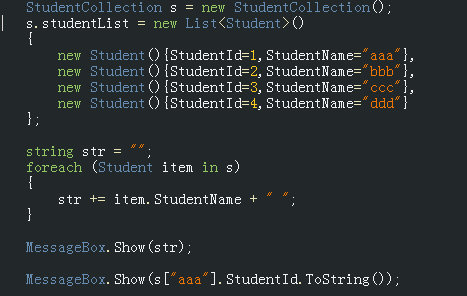C#迭代器与索引 简单示例
迭代器是一种设计思想和设计模式,在C#中可以方便的实现一个迭代器,即实现Ienumerator接口。例如我有一个student类,现在想封装一个studentCollection,代码是这样的:
Student类:
 StudentCollection类:
StudentCollection类:
 很简单的封装,仅有一个字段,那就是studentList,类型是list<Student>,实现Ienumerator接口的代码我借助了studentList,因为这个类实现了这个接口,因此拿来用就好了。这样我就可以对studentCollection进行foreach遍历了:
很简单的封装,仅有一个字段,那就是studentList,类型是list<Student>,实现Ienumerator接口的代码我借助了studentList,因为这个类实现了这个接口,因此拿来用就好了。这样我就可以对studentCollection进行foreach遍历了:
 代码说明:
代码说明:
1. new 一个studentCollection对象,并使用初始化器一一初始化每一个student对象
2. 用foreach遍历每一个student
3. 取得每一个人的名字累加到字符串,然后弹出提示框显示
有其他方式实现Ienumerator这个接口吗?答案是肯定的,代码如下:
public IEnumerator GetEnumerator()
{
foreach (Student s in studentList)
{
yield return s;使用yield关键字实现迭代器
}
}关于索引符以及索引符重载:
细心的读者可能已经发现了,在studentCollection类中,我定义了两个索引符:
通过索引来访问
public Student this[int index]
{
get
{
return studentList[index];
}
}通过学生姓名来访问
public Student this[string name]
{
get { return studentList.Single(s => s.StudentName == name); }
}索引符重载机制使得封装显得更灵活,更强大。

